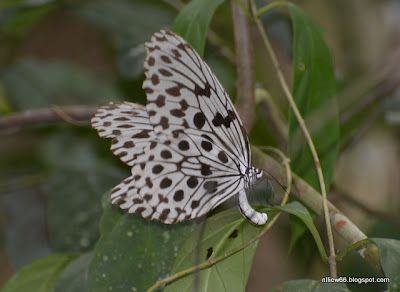The Malayan Tree Nymph is not a very common insect in general but in certain elevations, it is more evident. It can often be seen gliding silently and gracefully, sometimes in pair in mid-storey under the sun-speckled forest canopy. Under this condition, the speckled wings gives a good camouflage but once it crosses an open path or a jungle road, it suddenly becomes a spectacle for anyone who has seen it drifting loftily across a road shoulder - an unusually large and fragile floating semi-transparent piece of an insect with prominent dark spots, giving rise to its name "Surat" in Malay which means "letter". This is decidedly a forest insect and can be seen sometimes cohabiting with a commoner but slimmer and more elongated species the Common Tree Nymph, Idea stolli logani (Moore) which inhabits the same localities.
Frequency observation chart: (S marks the usual occurences, H marks an unusually high occurence, F for first record)
Habitat indicator
RSP
|
WV
|
PG
|
VF
|
FTR
|
SC
|
LWDF
|
LWPF
|
LMEF
|
UMN
|
MN
|
x
|
x
|
x
|
Frequency observation chart: (S marks the usual occurences, H marks an unusually high occurence, F for first record)
2013
| |||||||
Mac
|
Apr
|
May
|
Jun
|
Jul
|
Aug
|
Sep
|
Oct
|
S3
|
S3
|
S3
| |||||
2013
|
2014
| ||||||||||
Nov
|
Dec
|
Jan
|
Feb
|
Mac
|
Apr
|
May
|
Jun
|
Jul
|
Aug
|
Sep
|
Oct
|
| S3 | |||||||||||
2014
|
2015
|
||||||||||||
Nov
|
Dec
|
Jan
|
Feb
|
Mac
|
Apr
|
May
|
June
|
Jul
|
Aug
|
Sep
|
Oct
|
Nov
|
Dec
|
S3
|
S3
|
S3
|
S3
|
||||||||||
2016
|
|||||||||||
Jan
|
Feb
|
Mac
|
Apr
|
May
|
Jun
|
Jul
|
Aug
|
Sep
|
Oct
|
Nov
|
Dec
|
S3
|
S3
|
S17
|
|||||||||
2017
|
|||||||||||
Jan
|
Feb
|
Mac
|
Apr
|
May
|
Jun
|
Jul
|
Aug
|
Sep
|
Oct
|
Nov
|
Dec
|
S
|
S
|
S3S5
|
|||||||||
2018
|
|||||||||||
Jan
|
Feb
|
Mac
|
Apr
|
May
|
Jun
|
Jul
|
Aug
|
Sep
|
Oct
|
Nov
|
Dec
|
2019
|
|||||||||||
Jan
|
Feb
|
Mac
|
Apr
|
May
|
Jun
|
Jul
|
Aug
|
Sep
|
Oct
|
Nov
|
Dec
|
These photos were captured on 17 March 2013 @ 13:55 by a stream. I was about to take a dip in the stream when I suddenly saw a huge white butterfly hovering on the same spot for a moment. I grabbed my camera and took a few shots but because I only had a 105mm lense, the results were not so satisfying as the insect must have been at least 10 feet away from me and I didn't want to get too near so as not to spook it. This butterfly is a very restless insect despite its fragile looking demeanor...
* * * * *
On 5 August 2013, I observed a number of Tree Nymphs in different locations and one particular female descended from the mid-canopy to lay eggs on a semi-hardy woody bush found commonly in the area, usually among the undergrowths...
The food plant of the Tree Nymph...
* * * * *
A drifting pair: 14 August 2013 @ 12:17
This one came to rest on a medium-height bush along a jungle path on 16 September 2013 @ 15:19. It is observed that the Tree Nymph can become common in places where its food plant is abundant (see above).
Unusual habit: This male was seen along a wooded village trail at ground level nectaring on Asystasia gangetica. 15 Oct 2016 @ 11:30




















No comments:
Post a Comment